The first municipality in Spain
Thursday, August 25, 2016
Do you know which is the first municipality in Spain?. Well, it is Brañosera (in the province of Palencia, in the region of the Montaña Palentina, Community of Castile and León, to the south of the Sierra de Hijar).

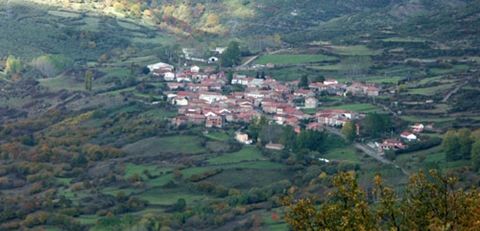
 (1) a 40 mm.jpg)
Brañosera
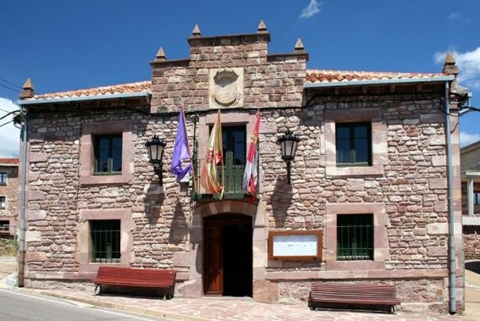
The Council of Brañosera
The Sierra de Hijar has a tableland named Sierra of Peña Labra.
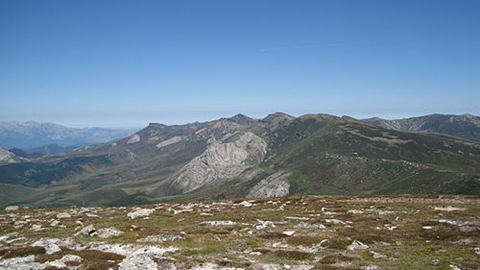
Sierra de Hijar with tableland Peña Labra

Peña Labra (on the left side of the image)
It is considered the first council of Spain, when they gave the first “carta puebla” (“municipal charter”), (then still part of the Kingdom of Asturias), in 824.
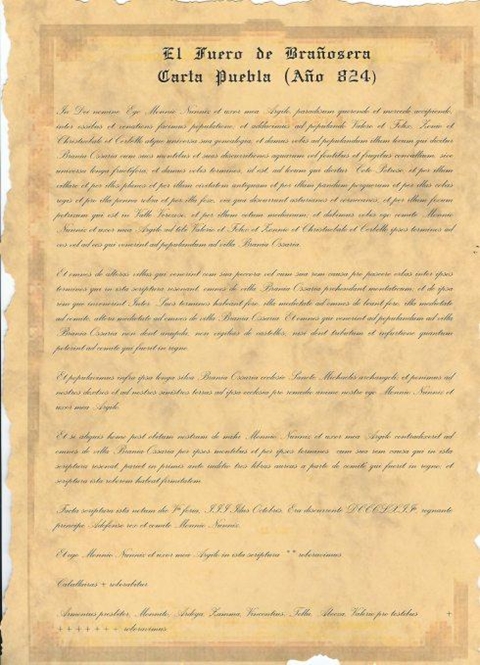
The Municipal Charter
It is one of the towns of the Camino de Santiago (Road to Santiago), in the north of Spain: Route of the Besaya (Among Santander and Carrión de los Condes –to the North of the province of Palencia--).Brañosera is 118 kilometres from Santander.
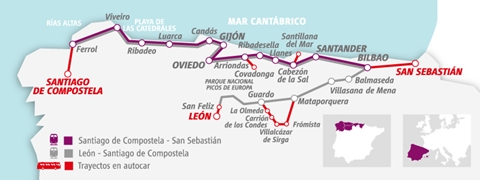
Santander to Carrion de los Condes
Brañosera is included in the called “Montaña Palentina” (Mountain of Palencia), inside the Natural Park of Carriona Springs and Copper-Mountain of Palencia Spring, and dominated by the buttresses of the Sierra de Hijar, the Valdecebollas massif. The Rubagón river, which irrigates the municipal boundary of Brañosera, born in these mounts. It is surrounded by forests of beech, oak, holly and yew.

Valdecebollas, 2,139 mts high (On the right side of the image)
Most likely, according to studies, conducted by historians from Santander, and as noted by the Charter of Brañosera, the mythical Celtiberian city of Vadinia is located in its limits; Vadinia, that was a Cantabrian bastion, in the resistance against the Roman Empire.
There is a place, where vast forests are covering the slopes of stunning mountains, that rise majestically.
It is the area of Leon-Asturian mountains, a place full of myths, legends, old customs that are rooted, in the oldest thing of tradition, of villages where they seem to have stopped time, with kind and wise people, willing to chat with traveler and convey all their cultural legacy of centuries, of stunning scenery, attractive, bewitching, full of an ancient magic and beauty, that inevitably catch traveler.
Its location, halfway between the northeast of Leon, the east of Asturias and even the western Cantabria, tells us about its past, linked to a tribe of Cantabrian origin: the Vadinienses (people from Vadinia).
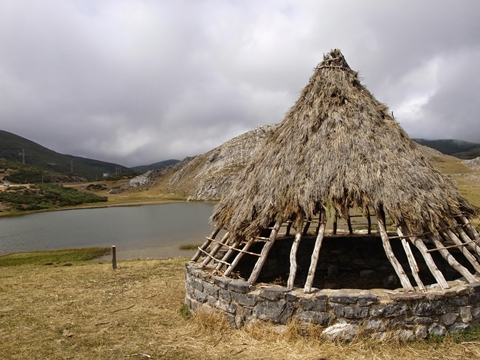
A hut for people from Vadinia on the Isoba Lake
According to historian Ptolemy, this tribe would be part of one of the 8 "civitates", in the Cantabrian nation was divided, the Vadinienses would be formed by four clans: the Arcaedunos, the Aroniaecinos, the Cantianos and Corovescos. Its specific location is a mystery, placing them, according to many authors, in the area of the current village of Buron, others in Cangas de Onis and others place them in Crémenes; the only evidence, that we have, are the multiple steles appeared, in several villages in the area, Vadiniense indisputably origin, dating to the third Century Before Christ.
Its distribution was on both sides of the Cantabrian mountain range; to the north, they stretched across the lands of Ponga and Sella, reaching the Cantabrian Sea; to the south of the mountain range, its territory included the lands of Leon Eastern mountain to a little bit below Cistierna; on the East, the Carrión river closed the territory and, on west, the top of the Porma, near Puebla de Lillo, and the beautiful lake Isoba.
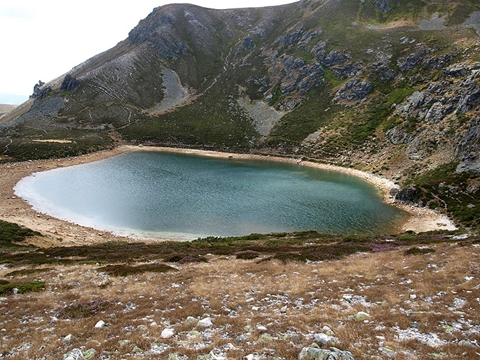
The Isoba Lake
Their culture was eminently based on forts, and matriarchal; its main city would be Vadinia, whose exact location is unknown, there are no many remains of forts from Vadinia preserved, or they are not excavated, as an example we have of Castitejón, near Isoba.
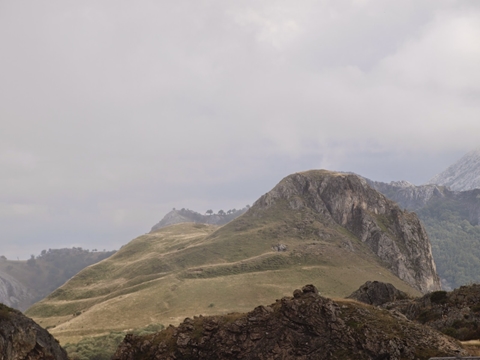
Fort of Castitejón
After the Cantabrian Wars, there was no record of activity, in the area, until the repopulation, in the ninth century. It is then that it was necessary to colonize the lands of the Plateau, to supply the emerging number of Christians, who lived in the mountains of northern Hispania. The borders, on the Duero (river), were set and kings, bishops, followed by settlers and serfs, moved to these lands, to establish the boundaries of a civilization, rise and expansion. These places lacked natural defenses, so it was necessary to create, on hills and mountains, castles with a mainly defensive role. The counties were dominated by a 'Come "(Count), who got this title for his victories against the Muslims. It is believed that the founder of Castile, having conquered the lands of the Arabs, was Rodrigo of Castile, and later became Fernan Gonzalez, who according to tradition, he got the independence of the County of Castile.
That was how the foramontanos (people from the north of the Iberian Peninsula, with which, in the ninth century, repopulated El Bierzo and lands to the north of the plateau of the Duero, which were empty because of the wars between the Muslims and the Kingdom of Asturias) of Malacoria came from inside Cantabria. Following the birth of the Ebro, they penetrate in territory of "high brañas (braña is an area of the Cantabrian mountain range, where cattle can graze) and bears", that give the name to the place. These formed the council of Brañosera, covered by the Municipal Charter, granted by the Count, Munio Núñez, and his wife, Argilo.
In 824, Alfonso II of Asturias reigned. In those days, Munio Núñez was the Count of Brañosera lands.
For a century, the Peninsula lived the Arab invasion. This had caused the flight of Christians, to the north, and many of them, those who did not perish along the way, they came to take refuge in asturian lands, lands which immediately began to suffer overcrowding. Famine began to vent its rage on these "exiled" and they began the flight, in search of a better life. And they arrived Brañosera, until Brannia-Ossaria, brañas and bears lands.
Precisely, to organize the repopulation, Munio Núñez granted the Municipal Charter, to his subjects, endowing them with rights. He granted the free use of all, in the valley, with only two conditions: to give a part of that use, whom would come to populate the valley; and pay to the Count half the pay, that should be collected to the nearby villages, that had grazed their cattle in these areas. In return, the inhabitants of Braña-Osaria would be exempt from military surveillance and service in the nearby castles.
Thus it was born the Charter of Brañosera, the first Municipal Charter, dated October 13, 824, formally it constitutes the first local admistrative organization, the germ of current councils.
Well, I hope that you have liked this post.
Until my next article, kind regards,
Luis.
Sponsored by Costaluz Lawyers.
Please click below:

 3
Like
Published at 12:57 PM Comments (0)
3
Like
Published at 12:57 PM Comments (0)
The last megagliding on a Spanish island
Friday, August 19, 2016
Today, I would like to share with you an interesting article, about an island in the southern Spain.
The last of the 20 megagliding, that have been documented, in the geological past of the Canary Islands, which opened 80,000 years ago the valley of El Golfo, on El Hierro, has moved double rocks and materials, than which was estimated so far: 318 km3, almost 6% of the total volume of the island.

El Hierro island with the Valley of El Golfo
The megagliding of volcanic islands happen to be one of the most impressive phenomena of nature, or, at least, that is deducted by scientists for the "scars", left in Hawaii, in Cabo Verde and in the Canary Islands, because none of them has occurred in a recent past.
The scientific consensus believes these gigantic collapses of land occur because the volcanic islands grow so fast and so vertical, the base does not withstand the weight and its slopes can collapse suddenly, if they are destabilized by other natural phenomenon, like an earthquake, a rash or millennia of internal erosion by groundwater aquifers.

Slopes over the Valley of the Gulf
The latest studies on the gliding of El Golfo, published in 2011, date in a period between 39,000 and 97,000 years ago, and they estimated that it caused an avalanche of 150-180 cubic kilometres of land.

Rocks on the Valley of the Gulf
This spectacular gliding, occurred after collapsing the northern slope of the volcano of El Golfo (the volcano Tiñor), which had grown over 400,000 years, on the plain left by another megacollapse, 600,000 years ago.

Gully Tiñor

Megagliding of land
The authors review thoroughly the final collapse of the youngest of the islands of the Canary Islands, using seismic data, provided by the National Geographic Institute, the bathymetry and echo sounders, carried off its coast, by the Navy and the Spanish Institute of Oceanography (IEO) and a detailed study of the geology of the walls of the Gulf, forming an amphitheater of 15 kilometres amplitude, and all its water wells and galleries.
Their first conclusion is that the megagliding of the Gulf was, in fact, the succession of two collapses, separated only by "a few thousand years", that left, as a mark, on the north of the island, two overlapping natural amphitheaters: the first cast, on the Atlantic, about 243 km3 of rocks and, the second, about 84 km3.
Only the smallest, of those collapses, suddenly moved such volume of material as it is estimated that, in the worst case, the Vesuvius expelled, in eruption that buried the Roman cities of Pompeii and Herculaneum, in the first century or what is the same as 55 times the capacity of Mequinenza swamp, the largest reservoir of the Ebro Valley.

Panoramic views of the Valley El Golfo
The three scientific institutions, involved in this study, have also revised underground galleries, in which several marine deposits following that collapse are appreciated, that were covered by other eruptions, in El Hierro, later. In them, they have found areas of erosion that allow them to calculate that the collapse of El Golfo happened between 23,500 and 82,500 years ago.
The characteristics of the remains, buried by lava, lead them to think of a time with the same sea level than today, among the last two ice ages, so they consider that the most likely is that all happened about 80,000 years ago.
As for the remains found under the sea, the proportions which those reveal, on this megagliding, they are not minor: the northern slope of the volcano of El Golfo generated an avalanche of boulders up to 1.5 kilometres long and 300 metres high .
Finally, the article announces that possible remains of more recent undocumented landslides have been found, in that area of El Hierro, so the landslide of El Golfo would not be the last one.
That would explain the datings, offered by the registration of undersea deposits, caused by ancient tsunamis, that exists in Madeira funds, to the north of the Spanish archipelago, suggesting that other megagliding, occurred in the Canary Islands, about 17,000 years ago.
Well, I hope that you have considered this post as interesting as I do.
Until my next post, kind regards,
Luis.
Sponsored by Costaluz Lawyers.
Please click below:

 0
Like
Published at 1:50 PM Comments (0)
0
Like
Published at 1:50 PM Comments (0)
A very rich spanish production
Thursday, August 11, 2016
Today I would like to talk to you about a very important Spanish production, for our economy and for our own consumption. It is the production of various vegetables, by a spanish company, located in the East: the company ALVALLE.
I bring you a video, in which is very well explained the process of production.If you want to watch this video, please click on the link below:
http://www.rtve.es/alacarta/videos/agrosfera/agrosfera-mucho-gusto-alvalle/3672894/
Below the image, you can read: Alvalle. Spain Food Award.
Voice in off: “This is the origin of all industrial process of Alvalle ...: tomatoes grown in these gardens, mostly in Murcia, all in East, at a maximum distance of 200 km from the factory; so that both tomatoes and cucumbers, peppers, onions, garlic ..., all vegetables are harvested and can begin processing, within a maximum of three hours. The company has agreed, with farmers, the right time of collection”
Rosario Sáez (Responsible shopping for fruits and vegetables): “We buy it ripe, ripe, directly from the field; thus, it comes here, with this red coloration to the plant; and so is the quality and taste of the product ... that is the secret”
Voice in off: “And together with vegetables, aromatic herbs and other basic ingredient ....”
Rosario Sáez: “The oil, that we buy, is an Extra Virgin olive oil, with designation of origin ... ,it comes from Jaén and has a very special flavour profile, for our gazpacho”
Voice in off: “In high season, every week, here comes more than half a million of fresh vegetables; the first step is to wash them .... It comes time to cook; It is an industrial process, but the essence is the same as the traditional making, so that the ingredients are ground and mixed, following the recipe chosen for each product”
Gerardo García (Planning Manager): “After a year, we are manufacturing twenty-seven thousand litres of gazpacho .... As of today, the 50 percent of our products is intended for export to countries like France, UK, Portugal and Belgium”
Voice in off: “In this factory, seventy people work, who are involved in an exclusive tastings system”
Isabel del Cerro (Quality manager): “People from different areas of the company, come and look at the product, like it should be looked by the person, who should buy it on a surface (shop). We taste the gazpacho, to see which is how we like quality, as consumers would like”
Voice in off: “The whole process is based on the Principle of circular economy: reuse to save”
Andres Mora (Responsible Safety and Environment): “In the last ten years, we have reduced specific water consumption, ie litres of water per litre of gazpacho produced, by 60 percent, and the same on energy”
Voice in off: “97 percent of the residues is reused; for example, leftovers, scraps, they also have a destination”
Andres Mora: “The residue, that you just saw, vegetable residue, for example going to feed cattle”
Voice in off: “Innovation in a company about to turn forty years”
Gerardo García: “Alvalle was founded, in 1987, by a group of local Engineers from Murcia. A famous phrase, that the founder of Alvalle said, is that "Actually, in this plant, we manufacture time, which is the time saved, at home, to make the best gazpacho"”
Voice in off: “The effort to innovate in such a traditional product, the use of local raw materials and dissemination of the values of the Mediterranean Diet have made them worthy of the prize "Food of Spain 2015 to the foodstuff Industry"”
Well, I hope that you have liked this video and want to taste the “Gazpacho Alvalle”. But, in case you have just tasted it, please tell me your experience.
Until my next post, kind regards,
Luis.
Sponsored by Costaluz Lawyers.
Please click below:

 0
Like
Published at 6:29 PM Comments (0)
0
Like
Published at 6:29 PM Comments (0)
My own recipe of Spanish beef stew
Friday, August 5, 2016
The day before yesterday, I cooked a beef stew and I thought that maybe you would be interested to know how I did it. So, I took a picture of it, when I finished, and I thought to give you the recipe and put the picture here.
The recipe is very simple. These are my Ingredients (for 4 persons): ½ kilogram of beef (a calf). 2 onions. 3 cloves of garlic. 1 large potato and 3 small. 2 large carrots. A little bit of white wine. 1 tablespoon with olive oil. 2 small tablespoon with Bovril (a salted beef extract) –I like Bovril, because it gives the stew a brown colour, with a meat flavour--.
Then, I did the following: I peeled the potatoes and put them under water, to remove the starch; I cut the potatoes into rather small cubes. After that, I peeled the carrots and cut them into slices. I also peeled the onions and chopped not elongated but very very small cubes. Then, I peeled and chopped 3 cloves garlic. Then, I put the onion and garlic, to sautée, in a pressure cooker. After one minute, stiring the onion and the garlic, I put the meat --which I had already cut into rather small cubes--.
When the meat was braised, I put the potatoes --and I stired everything--. I poured the carrots --I also stired everything--. Then, I poured a handful of fine salt and a little bit of white wine. I stired everything, several times, over a high heat, in order that the alcohol was evaporated .After 5 minutes, more or less, I poured the Bovril and a glass and a half of water. Always stiring everything.
After 2 minutes, I closed the pressure cooker and I left it with a low heat during 12 minutes.
Then, I opened the pressure cooked and I found this one:

Well, I hope that you have liked the recipe and hope that you want to try to cook it. If you do that, please tell me it.
Until my next post, thank you for reading my blog and kind regards.
Luis.
Sponsored by Costaluz Lawyeres.
Please click below:

 0
Like
Published at 12:28 PM Comments (2)
0
Like
Published at 12:28 PM Comments (2)
The Botillo: a typical product from the Northwest of Spain
Thursday, August 4, 2016
Talking about León again, I should like to recommend you to ask for Botillo –a very typical product, made in León, Galicia and Asturias--.
The Botillo is a meat product, made with chopped pieces, obtained from cutting pork, seasoned and stuffed into the blind (Ciego) pig, which is then smoked and semi-cured.


The Blind (Ciego), almost to the right side and below

The Botillo
The word “Botillo” comes from the Latin Botellus --diminutive of "botulus", which means "Cold meat" --.
This is a very old product, because in certain Roman culinary treaties they talk about it --although, of course, without adding paprika, since it was first discovered, in America, after adding pepper and being grown in the Bierzo--.
The oldest medieval written references, that remain (in original documents) date from the XI-XII century, in which we talk about the obligation was to deliver a certain amount of "botellus", to the Monastery of San Pedro de Montes, by that they lived in its domains.—
The only name, that is under the protected geographical indication and which is marketed as El Bierzo, is "botillo", but it is also popularly known, in some places, along with the name of "Pastor" --in certain areas of the Bierzo, La Cabrera and Valdeorras /Zamora), it is told the story about a well-known character (the Losada watchmaker), who was a shepherd, at La Cabrera, and one day, in his youth, after returning with sheeps, at bedtime, he heard how his masters said that, the next day, they were going to eat the shepherd and, believing that they referred to him, instead of to botillo --since he did not know the name of "Pastor"--, then he escaped, what led him to cross multiple countries, where he subsequently made a fortune.
The Botillo of El Bierzo is a meat product made from different pieces, obtained from cutting pork (rib, tail and little fleshless bones), chopped, seasoned with salt, paprika and garlic and other natural spices, stuffed into the blind of pig, smoked and halfcured. We can also add language palette, cheek and spine, whenever not exceed 20% . It is usually consumed cooked, wrapped in a cloth mesh or with nothing, but carefully avoiding breakage and getting water. It has a denomination of own origin.
Seasoned with chorizo, ear and nose of pork, with a very tender cabbage, it results in a tasty and wholesome stew.

An stew with Botillo, chorizo and berza
Also, sometimes, it being less common, they are added chickpeas as garnish.

Botillo of El Bierzo has an organism, that regulates its quality and authenticates its origin, called Regulatory Council of the Protected Geographical Indication Botillo of the Bierzo. The Androlla or androya is also typical of the Bierzo.

Androlla
In the municipality of Bembibre (in the Bierzo), since 1972, it is celebrated the National Festival of Exaltation of Botillo, during the month of February. It is a great meal, where more than 1,000 botillos, among the more than 1,200 attendees diners, are consumed. A flock of celebrities of arts, letters and politics go there, from all Spain. The Fiesta, which is declared of Regional Tourist Interest and interest in Castilla y Leon, becomes magnet for people, both inside and outside the province.

The famous spanish singer, Shaila Durcal, eating on the top of this table, in Bembibre.
There are other festivals, celebrations and awards of the botillo, in which the Botillo is the protagonist, in several villages of El Bierzo, between which are the “Festival of the botillo” in Fabero, in Folgoso de Ribera, in Torre del Bierzo, in Boeza and the tastings organised by the Gastronomic Brotherhood Real Botillo del Bierzo, even outside of Spain.

Fabero
The last February, it was celebrated the 19th Festival del botillo, in Fabero.

Well, I hope that you have liked to know about “the Botillo” and hope that you can go to El Bierzo, the next year or as soon as possible.
Until my next post, kind regards,
Luis.
Sponsored by Costaluz Lawyers.
Please click below:

 0
Like
Published at 12:39 PM Comments (0)
0
Like
Published at 12:39 PM Comments (0)
Spam post or Abuse? Please let us know
|
|